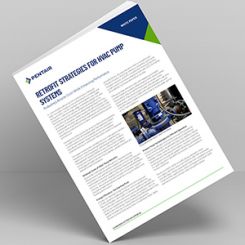Pumps & Systems, July 2008
Shrinking resources and growing customer demands have created a whole new world for packaged systems. Not long ago, packagers were simply build-to-print suppliers. Their customers did all the design and engineering, and the packager merely put the pieces together. Those days are going fast. Market shifts have forced companies to downsize engineering and design staffs. The cutbacks have helped businesses realize it is more profitable to tighten their focus on what they do best-for example, pumping oil, not creatively designing hydraulics or engineering a full scope of supplies for a pipeline. That renewed focus, coupled with the growing demand for speed and cost efficiencies, has led many companies to turn to packaged system solutions.
Moving to packaged systems means leaving the design and engineering to experts-experts with skills most companies do not possess in-house, and experts who can quickly produce drawings and designs, then swiftly deliver a finished product. Packaged systems are also application-specific. They meet the unique needs of each individual customer with a single source for every component, so in-house staffs no longer have to cobble together all the pieces.
Clearly, these are not your father's packaged systems. Expanding your definition of packaged systems means changing the way you look at what they can do for you and your business. So how should you look at packaged systems? Here are a few examples of how some companies used them to meet a range of wants and requirements that a collection of components could not.
Elevator Manufacturer
A large North American manufacturer of in-home elevators was recently looking for a hydraulic package with an unusual combination of quiet and compact features. Because the hydraulic package itself had to sit in the shaft of the elevator, it had to be extremely small. Because the company's new generation of elevators no longer required a separate machine room elsewhere in the house, the package also had to be incredibly quiet. The elevator manufacturer did not have the in-house pump or hydraulic expertise needed to build such a small solution. Since it needed a new, creative design, the company turned to a packaged solution approach that quickly and cost-effectively compiled hydraulics that that were extremely quiet and would fit into such a small envelope.
Compressor Manufacturer
A major compressor manufacturer who faced a different set of challenges also determined that a packaged system was the right solution. In this case, the company wanted to modularize the way it manufactured its compressors to cut costs and increase productivity. The compressor manufacturer broke out its compressor production processes into a series of modules, including controls, gearboxes and lubricating systems. The objective was to create a true plug-and-play package in which all the components were outsourced, and then assembled at the factory. In other words, all the pieces were standalone components that could be brought together to work as a single unit.
Instead of just a pump, the company wanted an entire lubrication package. It turned to outside experts who could design and deliver a solution that met the demands for modularity. By switching to a packaged system provider, the company was able to work with a specialist who could look at the commonality of everything-motors to hosing, heat exchangers and hydraulics-and design a family of modular lubrication packages that provided the proper balance between the cost of assembly and the cost of components.
The company discovered another built-in benefit to packaged systems: labor savings. All too often people only look at the cost of components when designing such a product. Sometimes you must select a more expensive component in order to put the product together faster. That is a critical consideration; any savings on labor costs lowers one of the major expenses of the manufacturing process.
As they look for new and better ways to take advantage of packaged systems, companies like this manufacturer are seeing the benefits of working with suppliers with lean manufacturing techniques that allow them to build the systems faster and at lower labor costs. Don't confuse lean manufacturing with cheap manufacturing. Yes, lean manufacturing does save on design and assembly costs, but not necessarily on the cost of individual components. The real cost-saving feature of lean manufacturing and the packaged systems it can produce is speed. The faster and smarter you can work, the more competitive you can be in the marketplace-no matter where your labor force may be located.
Petrochemical Company
Finally, a major Latin American petrochemical company also wanted to move beyond mere pumps toward a packaged system solution. The company's oil field installations were frequently in remote locations where it was difficult to deliver significant infrastructure. The customer wanted and needed a larger, more finished package. The result was a pumping skid that included the pump, the motor, the baseplate, the transmission and all the sensors and electrical work. The new skid was a complete package that was easier for the company to install and met the rugged requirements of oil field pumping.
Conclusion
These companies, and others like them around the world, have discovered that packaged systems can offer added value and lower overall costs through solutions custom-tailored for complex tasks. In fact, packaged systems open up a gamut of opportunity for just about everyone. They are no longer limited to metering systems or big oil field skids. There are countless other applications where the speed of design and delivery can pay significant dividends.
Today's packaged systems are light years ahead of where most of us think they are. Demand for these solutions changes and grows every day, and perhaps so should our thinking about the true definition of a packaged system.

